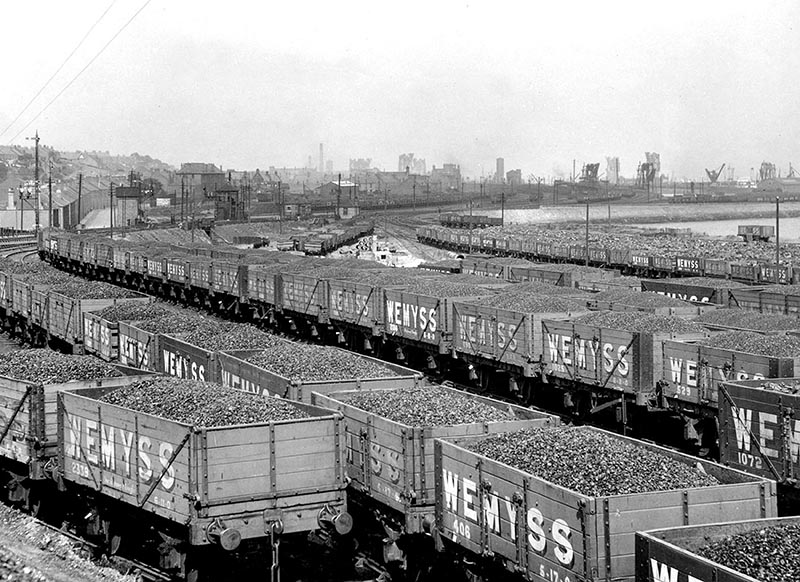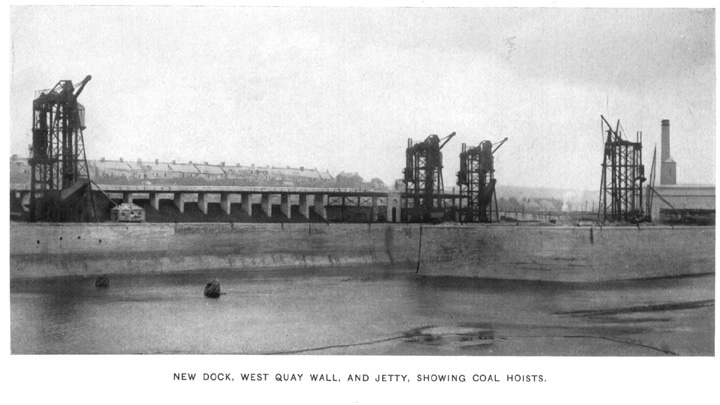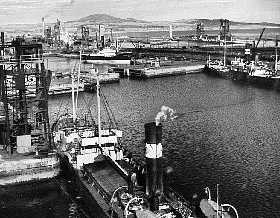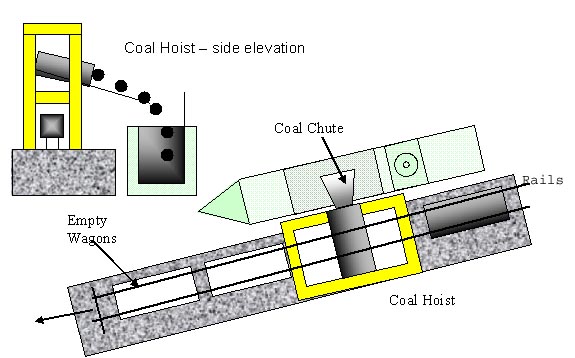Coal Handling at Methil
"For the export of coal the excellent coaling facilities are unsurpassed at any other Scottish port, and very creditable performances stand to the record of the port. Recent shipments include the loading of the SS "Queensworth" with 2,974 tons of coal in 4 hours; the SS "Relillis", with 3,824 tons in 12 hours; the SS "Mokta" with 6,724 tons in 15½ hours; and the SS "Woodfield" with 7,907 tons in 29 hours". [ LNER (London North Eastern Railway) booklet 'Ports', published in 1936].
Coal was the handmaiden of the industrial revolution – a term first used by a Frenchman, Jérôme Adolphe Blanqui in 1827: “While the French Revolution carried out its experiments on a volcano, Britain tried out hers in the field of industry”. Coal fuelled the steam engines that powered both industry and transport: Britain had no other indigenous fuel, at least in any quantity.
As industry expanded so did the demand for coal; a demand readily satisfied by the coal owners of Fife! Development of the docks at Methil enabled the shipment of over three million tonnes of coal annually. Movement from the pithead to the docks was by rail; over twenty-five miles of sidings existed between the Wellesley colliery and the docks. This network could hold up to fifty thousand tonnes of coal, all for export, that is, some three thousand wagons, at any one time.

Coal was loaded into ships using Coal Hoists. These were large structures, 60 feet (18 metres) high, fixed to the dock, standard gauge railway tracks running through their open bases. Each hoist was capable of lifting a railway wagon carrying up to twenty tonnes of coal. The number of hoists varied between the docks with No.1 dock having one hoist, No.2 dock, three hoists and one coaling crane, while No.3 dock was equipped with six hoists. This dock had a berth equipped with two hoists, both capable of being used at the same time for loading a single vessel. The two hoists at this berth were so placed that, assisted by the radial movement of the coaling chutes, the largest vessel coming to the port could be coaled at all four hatchways without the vessel being moved. Weighing machines were provided at hoists in No. 3 Dock for weighing the loaded and empty wagons.

 |
 The ubiquitous Pug took the assembled wagons from the sidings to the docks. Each wagon was uncoupled one by one, and allowed to run by gravity, the speed being manually controlled, either by the wagon’s brakes or the use of a sprag, a piece of wood held against the wheel rim by men called "Spraggers" (Health and Safety did not feature in this environment!), onto a turntable at the base of the coal hoist. Using muscle power, the wagon was turned through ninety degrees until it was end-on to the ship, chained at the landward end, the pins holding the end door closed removed, and the wagon raised electrically to the loading chute. Once in position the wagon was tipped such that the weight of coal forced open the end-door, the coal falling into the ship’s hold. -a nosiy process - more so if the ship was empty! A gang of men, the Coal Trimmers, were employed to manually distribute the coal within the ship’s hold, thus maximising the load, but more importantly ensuring the stability, and hence the safety, of the ship. The now empty wagon was lowered to an intermediate level, unhooked from the chain and turned to face the rail lines and pushed off the turntable onto the rails, where it ran, by gravity, to join other empty wagons. The wagons were re-coupled and removed to a siding by the Pug to await collection back to the colliery. The process was a form of "Merry-Go-Round" - wagons taken to the pit, filled, taken to the docks, emptied and back to the pit and so the process continued.
The ubiquitous Pug took the assembled wagons from the sidings to the docks. Each wagon was uncoupled one by one, and allowed to run by gravity, the speed being manually controlled, either by the wagon’s brakes or the use of a sprag, a piece of wood held against the wheel rim by men called "Spraggers" (Health and Safety did not feature in this environment!), onto a turntable at the base of the coal hoist. Using muscle power, the wagon was turned through ninety degrees until it was end-on to the ship, chained at the landward end, the pins holding the end door closed removed, and the wagon raised electrically to the loading chute. Once in position the wagon was tipped such that the weight of coal forced open the end-door, the coal falling into the ship’s hold. -a nosiy process - more so if the ship was empty! A gang of men, the Coal Trimmers, were employed to manually distribute the coal within the ship’s hold, thus maximising the load, but more importantly ensuring the stability, and hence the safety, of the ship. The now empty wagon was lowered to an intermediate level, unhooked from the chain and turned to face the rail lines and pushed off the turntable onto the rails, where it ran, by gravity, to join other empty wagons. The wagons were re-coupled and removed to a siding by the Pug to await collection back to the colliery. The process was a form of "Merry-Go-Round" - wagons taken to the pit, filled, taken to the docks, emptied and back to the pit and so the process continued.
The complete operation from a wagon arriving at the hoist to leaving took around two minutes - a most efficient sytem.